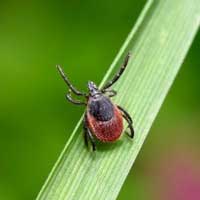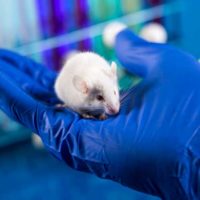ОБАВЕШТЕЊЕ ЗА ВЕТЕРИНАРЕ ПОШИЉАОЦЕ СЕРУМА ЗА FAVN ТЕСТ:
Формулар и уплатнице за FAVN је од сада могуће попунити on-line, тј. директно са сајту Пастеровог завода.
Након што попуните формулар на ваш e-mail ће бити послат примерак попуњеног формулара као PDF фајл. Формулар одштампати, потписати и оверити, затим послати са узорком који је обележен бројем микрочипа.
У наредном периоду ће још увек бити могуће слати ручно попуњене захтеве, ипак, охрабрујемо вас да прихватите нов начин попуњавања формулара.
За све информације, можете позвати 021 420-528
ОБАВЕШТЕЊЕ САВЕТОВАЛИШТА ЗА ЛАЈМСКУ БОРЕЛИОЗУ И ДРУГЕ БОЛЕСТИ КОЈЕ ПРЕНОСЕ КРПЕЉИ:
Уколико је крпељ уклоњен у другој установи, за даље анализе потребно је доставити крпеља спакованог са влажном ватом или газом у пријем Амбуланте за лајм борелиозу и друге болести које преносе крпељи, или се јавити лично уколико крпељ није уклоњен. Да би се извршила анализа крпељ НЕ МОРА да буде жив. Цена основне анализе крпеља је 500 динара.
Крпеља за анализу нам можете доставити и поштом.
За све информације, можете позвати 021 420-528
АНТИРАБИЧНА АМБУЛАНТА
Пријем пацијената је сваког радног дана од 7:30 до 14:30.
У случају озледе од животиње пацијенти се јављају свом изабраном лекару или Служби хитне медицинске помоћи. За информације у вези могуће вакцинације против беснила, обратити се на:
FAVN ТЕСТ
У оквиру Службе за микробиолошку и другу дијагностику врши се одређивање одређивање титра неутрализирајућих специфичних антитела против вируса беснила методом FAVN.
Обавештења, новости, едукације…
АКТУЕЛНОСТИ
Predstavnici Pasterovog zavoda na PSU-UNS Joint Conference on Medical Science and Technology 2023
28. Септембар – Светски дан борбе против беснила
Публикације и научни радови Пастеровог завода…
ПУБЛИКАЦИЈЕ
2023 |
|
Cases of Crimean-Congo haemorrhagic fever in North Macedonia, July to August 2023 Journal Article In: Eurosurveillance, vol. 28, iss. 34, 2023. | |
Tick-Borne Encephalitis Virus and Borrelia burgdorferi Seroprevalence in Balkan Tick-Infested Individuals: A Two-Centre Study Journal Article In: Pathogens, vol. 12, iss. 7, no. 922, 2023. | |
The Price of Hospital Reshaping: Nasal Myiasis Caused by Flesh Fly (Diptera: Sarcophagidae) in Reallocated COVID-19 Intensive Care Unit Journal Article In: Healthcare, vol. 11, iss. 11, no. 1533, 2023. | |
102
ГОДИНE
ПАСТЕРОВОГ ЗАВОДА
Оснивач и први директор је био др Адолф Хемпт, чија се вакцина против беснила користила у већини европских земаља, све до средине осамдесетих година прошлог века.
Пастеров завод у Новом Саду основан је 1921.године.
- Национална референтна установа за беснилоДанас је Пастеров завод национална референтна установа за беснило у Републици Србији и бави се превенцијом беснила људи и животиња, праћењем и контролом мера превенције. Пастеров завод је и национална референтна лабораторија за дијагностику беснила код људи и животиња.
 Med-Vet-Net асоцијацијаПастеров завод је члан мреже европских референтних институција, која има за циљ да промовише приступ једног здравља у борби против зооноза и антимикробне резистенције и подржава здрав и одржив ланац снабдевања храном широм Европе
Med-Vet-Net асоцијацијаПастеров завод је члан мреже европских референтних институција, која има за циљ да промовише приступ једног здравља у борби против зооноза и антимикробне резистенције и подржава здрав и одржив ланац снабдевања храном широм Европе Међународна мрежа података о векторима – VectorNetVectorNet је заједничка иницијатива Европске агенције за безбедност хране (EFSA) и Европског центра за превенцију и контролу болести (ECDC), која је почела у мају 2014. године. Пројекат подржава прикупљање података о векторима и патогенима у векторима, који се односе на здрављe животиња и људи. Пастеров завод Нови Сад је укључен у дистрибуцију података везаних за крпеље, у циљу процене ризика оболевања од болести које они преносе на територији Републике Србије.
Међународна мрежа података о векторима – VectorNetVectorNet је заједничка иницијатива Европске агенције за безбедност хране (EFSA) и Европског центра за превенцију и контролу болести (ECDC), која је почела у мају 2014. године. Пројекат подржава прикупљање података о векторима и патогенима у векторима, који се односе на здрављe животиња и људи. Пастеров завод Нови Сад је укључен у дистрибуцију података везаних за крпеље, у циљу процене ризика оболевања од болести које они преносе на територији Републике Србије.








